Are you a Quiet Speculation member?
If not, now is a perfect time to join up! Our powerful tools, breaking-news analysis, and exclusive Discord channel will make sure you stay up to date and ahead of the curve.
I've long considered myself a Delver die-hard when it comes to Modern. But I haven't been on much Delver at all since the Gitaxian Probe ban. Rather, the deck I've come to be known for in Boston is Colorless Eldrazi Stompy. In past weeks, I've reacted to local and online enthusiasm for the deck by crafting in-depth strategy primers on mulligans and sideboarding. Those two articles form a solid base for Stompy newcomers, but leave out a tougher-to-pin-down area I've taken for granted as a habitual Scourge-slinger: the deck's wealth of micro-synergies and in-game subtleties. This article seeks to rectify that.
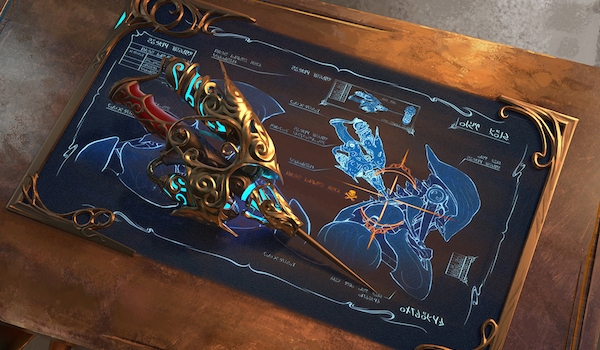
Primers often feature a little list of helpful tips at their closure. It turns out my list is 4,000 words long. Today, we'll look closely at the individual roles played by Stompy's more challenging cards, as well as the interactions between them that must be learned to succeed with the deck.
Before we get started, here are links to the other two entries in this series:
And my current decklist, for reference:
Colorless Eldrazi Stompy, by Jordan Boisvert
I'm actually playing a second Gut Shot over that second Surgical in the board right now, but as discussed in the last Mini-Primer, the spot is flex and doesn't affect any information here. For the sake of consistency, we'll leave the decklist untouched.
Wielding Threats
The second wave of Eldrazi are as known for their sheer bulk as for their funky text boxes. There's more to these creatures than they reveal on paper.
Eternal Scourge
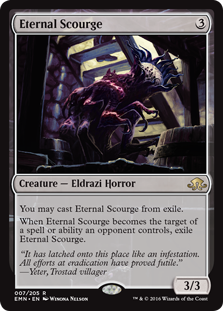 We'll kick things off with our lynchpin creature, Eternal Scourge. Before the game starts, Scourge plays a Ignoble Hierarch/Urza's Tower role in enabling Serum Powder and Gemstone Caverns, which set up our fast mana. After, it opens up a free win dimension against opponents relying on removal or combat (read: most of them). There are few keys to remember when it comes to successfully leveraging Scourge into a "free win."
We'll kick things off with our lynchpin creature, Eternal Scourge. Before the game starts, Scourge plays a Ignoble Hierarch/Urza's Tower role in enabling Serum Powder and Gemstone Caverns, which set up our fast mana. After, it opens up a free win dimension against opponents relying on removal or combat (read: most of them). There are few keys to remember when it comes to successfully leveraging Scourge into a "free win."
Against reactive fair decks, sit on Scourge indefinitely. In this situation, the creature's like Isochron Scepter with a Lightning Bolt, or a constantly flipping Huntmaster of the Fells // Ravager of the Fells: let your other resources pile up in hand while Scourge does the heavy lifting and chips away at opponents. Eventually, they'll be forced to start throwing removal spells at the thing; when they run out, we'll often still have Scourge, as well as a hand full of Seers and Smashers. It's fine to cast additional Scourges in this scenario (unless you fear sweepers and lack an exile effect), as well as Serum Powder.
These same reactive decks will still employ some proactive elements to actually close the game. Let's focus on Modern's best-performing reactive deck, Jeskai Tempo (the following principles in fact apply to all reactive decks). Their ideal line against Scourge is actually to try racing us, although many less-experienced pilots will fail to spot it and just hand us the game. Racing means end-step Spell Quellers and Snapcaster Mages. It's correct to kill these creatures on sight or add pressure to the board to combat these types of moves and maintain a damage advantage in the race. Sweepers like Supreme Verdict may also be employed to deal with Scourge, as well as tap-out math-changers like Geist of Saint Traft or Celestial Colonnade. These plays remove countermagic from the equation, affording us opportunities to cast the high-impact cards we have saved up.
Eldrazi Mimic
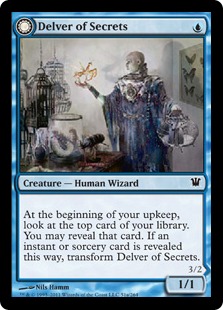 Our "Delver of Secrets // Delver of Secrets," Mimic's role is to pressure uninteractive decks early. It's almost always correct to run it out on turn one with a Temple or Gemstone in the dark (never a Guide, and turn one Chalice is a better blind play when available). Against removal-heavy decks, it can be fine to wait and lead on Eternal Scourge to soak up removal spells, but with a sweet creature curve, just slam the Mimic and continue adding threats to the board. In that case, opponents won't be able to keep up.
Our "Delver of Secrets // Delver of Secrets," Mimic's role is to pressure uninteractive decks early. It's almost always correct to run it out on turn one with a Temple or Gemstone in the dark (never a Guide, and turn one Chalice is a better blind play when available). Against removal-heavy decks, it can be fine to wait and lead on Eternal Scourge to soak up removal spells, but with a sweet creature curve, just slam the Mimic and continue adding threats to the board. In that case, opponents won't be able to keep up.
Mimic's also unique in this deck for its low mana cost. Given a hand full of Mimics and three-drops, take care to spend the most mana in each turn cycle—this deck is built to tap out. For instance, it's usually correct to cast a three-drop with three mana, even if we could draw Seer next turn and hit for an extra damage with Mimic. Next turn, then, we can cast both Mimic and a two-cost utility spell like Ratchet Bomb.
Matter Reshaper
Matter Reshaper occupies the same slot on the curve as Eternal Scourge, and similarly helps out-resource attrition decks. Reshaper's applications are a little different, since it provides a small burst of value rather than warp the gamestate around itself. To its credit, Reshaper also offers tempo, or mana, by putting the revealed card directly into play. Which of the two you want to cast first depends on the kind of resource a game values.
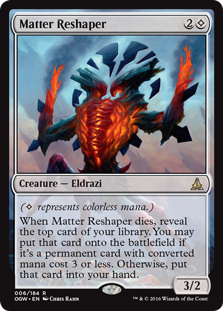 Since Scourge grants nothing for hitting the graveyard, Reshaper's a better blocker. We also want the tempo badly when under pressure, making it an ideal play against offensive creatures. That said, Scourge's larger body can change things when it comes to 2/x creatures like Thalia, Guardian of Thraben or Goblin Guide.
Since Scourge grants nothing for hitting the graveyard, Reshaper's a better blocker. We also want the tempo badly when under pressure, making it an ideal play against offensive creatures. That said, Scourge's larger body can change things when it comes to 2/x creatures like Thalia, Guardian of Thraben or Goblin Guide.
The two also fight for priority based on an opponent's removal options. Against reactive decks with a Chalice in play on 1, Reshaper should be played first—enemy Bolts, Pushes, and Paths become Command of Unsummonings against Eternal Scourge regardless of Chalice, making Reshaper a more reliable damage output. But without a Chalice, if you expect these removal spells, lead on Scourge to absorb them.
Endless One
Endless often functions as an additional Eldrazi Mimic. As with Mimic, it's fine to slam Endless One for 2 with a Temple in the dark, given a robust creature curve. Otherwise, it's best to wait a turn and see what opponents are packing. Endless has utility throughout the game; it's great fast versus linear decks, on the cheap to crew Copter or present a chump block, and on 4 or more against Bolt decks. Endless can also set up an alpha strike with one or more Mimics in the late-game.
Also like Mimic, Endless should be paced or played to ensure all our mana is spent each turn. In scenarios that could go either way, though, it should of course be preserved in hand, since it comes down for more later. But don't be afraid to slam Endless for 4 or even 3 despite the rate appearing lackluster. In a topdeck scenario, tapping out for a huge One often beats playing a smaller one to activate utility lands like Sea Gate Wreckage.
Thought-Knot Seer
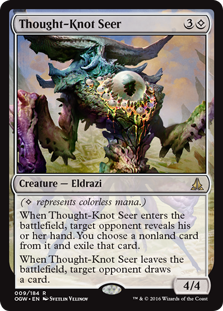 Should be saved for last in removal spell matchups, but resolved quickly against combo decks. An exception for the latter: don't rush Seer out if doing so means blowing Guides and messing up your curve. Our goal in combo matchups is to build the fastest clock possible while ensuring a Seer resolution before combo's critical turn, but as close as possible to that turn. Critical mass combo decks like Storm, as well as ones with mana cheats like Simian Spirit Guide, incentivize earlier Seers to mess with their assembling, get under oops-I-wins, and work the information for disruption purposes.
Should be saved for last in removal spell matchups, but resolved quickly against combo decks. An exception for the latter: don't rush Seer out if doing so means blowing Guides and messing up your curve. Our goal in combo matchups is to build the fastest clock possible while ensuring a Seer resolution before combo's critical turn, but as close as possible to that turn. Critical mass combo decks like Storm, as well as ones with mana cheats like Simian Spirit Guide, incentivize earlier Seers to mess with their assembling, get under oops-I-wins, and work the information for disruption purposes.
Reality Smasher
There's not much to say about this guy that isn't made painfully obvious by his ridiculous text box, but I'll mention that Smasher's an ideal threat to sandbag when it comes to playing around sweepers. Similarly, it's excellent against planeswalkers, which opponents go to great lengths to resolve on empty boards against us. Never walk Smasher into Liliana of the Veil against BGx. Just wait for another threat, or a mana to animate Blinkmoth in response.
Using Utility
Colorless Eldrazi Stompy's many utility spells also have some play to them.
Smuggler's Copter
In my article on sideboarding, I included Copter among the flex spot options for this deck, noting it should only really not be in the deck if everyone's playing Jund. I've since gotten in plenty of reps against Jund specifically, and have come to realize that Copter is actually insane in that matchup. As such, it joins the core and should always be included at 1 in this deck.
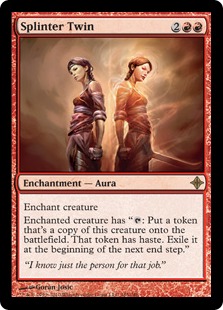 So why is Copter so good against Jund, a deck with a million ways to remove it at a parity gain? The card gives us what I like to call a Splinter Twin Effect. When UR Twin had Pestermite or Deceiver Exarch in play, opponents would fearfully represent one or two mana each turn as insurance for a possible combo kill. Twin leveraged the tempo stolen from that untapped mana to turn Pestermite and Exarch into legitimate threats on their own, a notion exemplified by Patrick Dickmann's Tarmogoyf-splashing Tempo Twin.
So why is Copter so good against Jund, a deck with a million ways to remove it at a parity gain? The card gives us what I like to call a Splinter Twin Effect. When UR Twin had Pestermite or Deceiver Exarch in play, opponents would fearfully represent one or two mana each turn as insurance for a possible combo kill. Twin leveraged the tempo stolen from that untapped mana to turn Pestermite and Exarch into legitimate threats on their own, a notion exemplified by Patrick Dickmann's Tarmogoyf-splashing Tempo Twin.
Similarly, resolving Copter heavily incentivizes opponents to represent Fatal Push mana each turn. And if they do, we've got plenty of other lines: casting and attacking with Eternal Scourge, for instance. It's almost never correct to actually crew the copter when opponents can kill it. At the end of the day, the only way they'll get past our Eldrazi Plan A is to impact the board, which forces them to tap out into Copter. It goes without saying that the amount of tempo we can gain from powering Copter out on turn one with Guide or Caverns is immense.
Opposing mana can also be dealt with proactively by casting must-answer cards like Thought-Knot Seer pre-combat, letting us crew Copter after opponents tap out to remove a creature or counter a spell. In Seer's case, the Eldrazi can crew Copter in response to removal, making the pairing especially deadly.
It's true that some decks don't need to impact the board in order to beat us—linear decks like Storm and RG Valakut spring to mind. These decks won't tap out so readily. But they also don't carry removal for Smuggler's Copter, letting us safely find Seers and Smashers to put things away. After all, Copter wouldn't produce a Splinter Twin Effect unless it was actually worth holding up mana for, but looting every turn and giving our creatures pseudo-haste (and flying) is really freaking good. If opponents want to let us do that, so be it; we'll bury them in high-impact cards.
 Things get even better for Copter. It's got some synergy with Eternal Scourge, especially post-board—discarding Scourge and then exiling it to Relic of Progenitus (or Scavenger Grounds) results in a straight plus; then, Scourge can be cast from exile next turn to crew the Copter again. The Vehicle also plays an important function for us by looting past dead cards, especially Phyrexian bricks like Dismember when our life gets too low to cast them, or more lands than we can play in a turn. Doing so turns Sea Gate Wreckage back on, letting us see up to three cards per turn and efficiently dig for answers to board stalls, prison elements, or other problems. (We used to have Urborg, Tomb of Yawgmoth to deal with uncastable Dismembers, but post-Grounds, we can't fit it.)
Things get even better for Copter. It's got some synergy with Eternal Scourge, especially post-board—discarding Scourge and then exiling it to Relic of Progenitus (or Scavenger Grounds) results in a straight plus; then, Scourge can be cast from exile next turn to crew the Copter again. The Vehicle also plays an important function for us by looting past dead cards, especially Phyrexian bricks like Dismember when our life gets too low to cast them, or more lands than we can play in a turn. Doing so turns Sea Gate Wreckage back on, letting us see up to three cards per turn and efficiently dig for answers to board stalls, prison elements, or other problems. (We used to have Urborg, Tomb of Yawgmoth to deal with uncastable Dismembers, but post-Grounds, we can't fit it.)
The opportunity cost of a single Copter is quite low, although drawing multiples when you need a pilot can stink (it happened to me once at last year's Regionals; lesson learned). As a result, I can't make a compelling case for the second Copter. A "favorable" metagame for that choice would be full of value-style Company decks, making Contortion and Bomb more attractive flex spot options. But at 1, the card's one of our strongest—if densest—utility options, and a clear staple going forward.
Relic of Progenitus
By now, Relic's proactive applications with Eternal Scourge are well-known. Less obvious is the related pacing. Against counterspell decks, for example, save Relic until after casting Scourge; opponents are likely to windmill slam Ceremonious Rejection or Logic Knot when they see the Eldrazi, turning Relic into a free plus on cast. Walking Scourge into Liliana of the Veil or Supreme Verdict yields similar results.
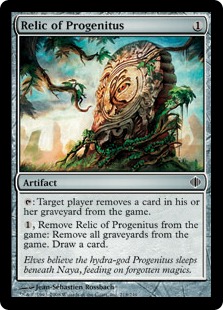 As for grindy opponents with artifact removal, it's ideal to represent Relic mana when possible. The primary benefit of doing so is to delay Relic's removal process. Reactive opponents versed in the matchup remove Relic on sight and take the minus in stride; the rest, hungry for "value," wait on us to tap out for Smasher. Instead, Scourge eventually puts them under enough pressure that they'll be forced to remove Relic at minus anyway just to get their own engines online.
As for grindy opponents with artifact removal, it's ideal to represent Relic mana when possible. The primary benefit of doing so is to delay Relic's removal process. Reactive opponents versed in the matchup remove Relic on sight and take the minus in stride; the rest, hungry for "value," wait on us to tap out for Smasher. Instead, Scourge eventually puts them under enough pressure that they'll be forced to remove Relic at minus anyway just to get their own engines online.
So the card is almost a guaranteed plus against reactive strategies, and often draws us many cards while disrupting opponents.
Ratchet Bomb
Like Relic, it's good to hold Bomb in hand sometimes, especially when we plan on cracking it for zero. That comes up against Storm (let them commit to Goblin tokens, which they are likely to in the face of graveyard hate) or Lingering Souls (wait for an opportunity to hit four tokens or kill them now and crash in for more damage), and Eldrazi Tron (Hangerback Walker and its tokens; Walking Ballista).
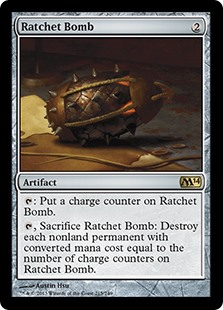 Conversely, in matchups where we're worried about a specific mana cost, Bomb needs to come down fast to start ticking up. Chief offenders include Gideon of the Trials, Geist of Saint Traft, and opposing Thought-Knot Seers. It's usually correct to tick Bomb up to the number just under our target's cost; that way we can add a charge counter on end step and blow that Geist before it blocks or attacks, and retain the option to kill Snapcasters in the meantime, for instance.
Conversely, in matchups where we're worried about a specific mana cost, Bomb needs to come down fast to start ticking up. Chief offenders include Gideon of the Trials, Geist of Saint Traft, and opposing Thought-Knot Seers. It's usually correct to tick Bomb up to the number just under our target's cost; that way we can add a charge counter on end step and blow that Geist before it blocks or attacks, and retain the option to kill Snapcasters in the meantime, for instance.
Pithing Needle
Needle is almost always saved until a target appears, unless we boast a truly fantastic curve, in which case we'll just hit the card we care most about. Common pre-emptive hits include Walking Ballista and Arcbound Ravager.
I was stoked for Sorceress Spyglass when it was spoiled, but testing has revealed its limitations. It's often a "three-drop" in this deck (we tend to start with Eldrazi Temple), which makes it incredibly clunky. And since we like saving our Needles anyway, the info only marginally improved the card. Clashing with Chalice never comes up with Needle, either; we Chalice for 0 against Affinity and side the artifact out in most other Needle matchups.
Surgical Extraction/Gut Shot
Free spells should usually be cast late, and reactively. For example, don't immediately Gut Shot that Ignoble Hierarch. Draw for turn first and see if anything changes. Sometimes it's better to spend turn one's extra mana on a freshly-peeled Dismember and save the Shot for a more mana-hungry turn.
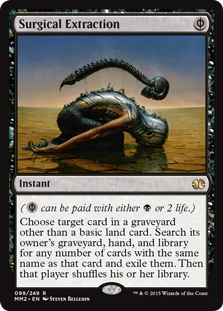
The same mostly applies to Surgical, although proactively tearing out Goremands or Path to Exiles can be correct before going for Reality Smasher or something. Surgical's one of those tricky cards that becomes better and better as format and matchup knowledge improves, and there's no way I could list all its uses in this section. The good news is, they tend to carry over from other Surgical-featuring decks.
One Stompy-specific thing to keep on the radar, though, and the reason a single Surgical is forever locked into this deck's sideboard, is the card's interaction with Eternal Scourge. Once opponents find a way to "permanently" remove the creature, Surgical allows us to put a full four of them into rotation, which generally ends the game.
Lands and Mana
One draw to Stompy over other Eldrazi decks is its manabase, which is composed of multi-purpose role-players.
Simian Spirit Guide/Serum Powder/Gemstone Caverns
Simian Spirit Guide is about accelerating into Chalice of the Void, but it has other uses. One can cast another, and Gemstone Caverns can cast them all. Spiting out a three-drop on turn one is fine if we have multiples and a sloppy curve. Surprise manland activations can also come in clutch.
 Post-board, Guide helps enable some of our plans. Chalice on 2 shuts down Storm and even RG Valakut in some games. Guide also lets us tap out for creatures with Relic in play and blow Storm out in response to Past in Flames. It works the same way with Dismember against creature-based combos.
Post-board, Guide helps enable some of our plans. Chalice on 2 shuts down Storm and even RG Valakut in some games. Guide also lets us tap out for creatures with Relic in play and blow Storm out in response to Past in Flames. It works the same way with Dismember against creature-based combos.
Serum Powder's not very exciting as a mana rock, but certainly passable. It gets us to Smasher on turn four without a Temple, and whenever we have exactly two mana to spare, it comes down free of charge (then tapping for whatever else we do). That comes up mostly with manland activations, Dismember, and Sea Gate Wreckage.
The card's also incidentally ridiculous against Wrench Mind out of 8-Rack, and hoses land destruction plans (especially Blood Moon, which is significantly worse than the cantripping Blood Sun against us).
Gemstone Caverns looks straightforward on paper, but it's not always correct to use it on the draw. Land-light openers without a two-drop play, or that want to lead on Relic, reward holding the Caverns in hand, especially against attrition-focused midrange decks. Other than that, pitching an extra Caverns or Powder is a great way to mitigate the drawback, and of course pitching Scourge results in a plus (we draw for turn despite functionally being on the play at no cost).
Mutavault/Blinkmoth Nexus
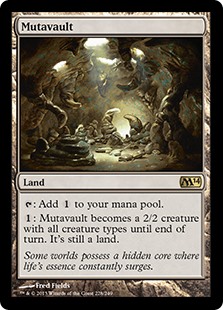 The idea behind utility lands is to ensure we've got uses for all our mana each turn, even after we've exhausted our hand. Along with Quarter, Vault and Blinkmoth most commonly activate before we run out of cards. Muta's the best on offense, although I've won many games by flying over board stalls. Blinkmoth's better on D, blocking evasive Affinity creatures (outright walling Signal Pest) as well as random stuff like Vendilion Clique. Blinkmoth can activate to pump itself after blocking, even the turn it comes into play, and can pump Mutavault—which is also an Eldrazi!
The idea behind utility lands is to ensure we've got uses for all our mana each turn, even after we've exhausted our hand. Along with Quarter, Vault and Blinkmoth most commonly activate before we run out of cards. Muta's the best on offense, although I've won many games by flying over board stalls. Blinkmoth's better on D, blocking evasive Affinity creatures (outright walling Signal Pest) as well as random stuff like Vendilion Clique. Blinkmoth can activate to pump itself after blocking, even the turn it comes into play, and can pump Mutavault—which is also an Eldrazi!
Mutavault's also a Merfolk, AKA a River Bear when opponents control Lord of Atlantis. I happily learned this at a PPTQ last summer when a spectating judge walked over to our table and informed my dumbstruck opponent that he was actually dead to my last-ditch attack.
When it comes to aggression, don't mindlessly animate manlands unless you don't mind losing them (which does come up). If possible, sponge removal with Scourge before formally calling on the backseat army.
Ghost Quarter
Our main "disruption land," Quarter helps us keep up with purer big mana strategies and disrupts land-based combos based on stuff like Gavony Township (or, more recently, Search for Azcanta // Azcanta, the Sunken Ruin).
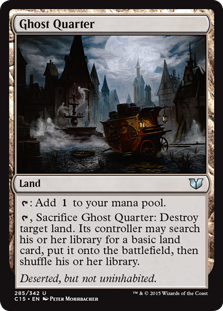
It also destroys manlands, notably Celestial Colonnade and Blinkmoth Nexus. Against said manlands, it's frequently optimal to "quarter" Ghost Quarter off to the side and wait until opponents animate (which may be never). Destroying manlands proactively is only worthwhile when doing so mana- or color-screws opponents, which is rare in non-Affinity matchups.
Screwing opponents is an important aspect of the card. Grixis Shadow only plays two basics, meaning a Quarter-heavy opener can actually tear up their mana. It's also good to pop red lands against that and many midrange decks, as Blood Moon's existence incentivizes many of them to skimp on running Mountain. Getting red back immediately then costs three life, which makes an attack from our manlands more attractive. This kind of "color-pop" is best executed on an opponent's end step, to ensure they don't have the color available next turn.
As a general rule, though, blowing up lands should take place on an opponent's draw step, especially against basic-light decks like Tron and Shadow. That way, there's a chance they've drawn a basic for turn and have to miss the Quarter search. (Same deal with Surgical Extraction.) Careful against Jeskai Tempo, though, which can sometimes spend the extra mana from the land we target on Canoptek Scarab Swarm or a Bolt effect.
Lastly, Quarter can target our own lands in a pinch. Sometimes we need to lock in a colorless mana source in response to Blood Moon; others, we want to fizzle a Spreading Seas draw—or just turn our blockers back on against those pesky Merfolk.
Sea Gate Wreckage
 Sea Gate Wreckage's role is to help us out-card opponents in a stall. It's useful against slower aggro decks, when the board can become gummed up, and of course against attrition strategies. We can activate one Sea Gate in response to the other, since they both meet the activation condition of no cards in hand.
Sea Gate Wreckage's role is to help us out-card opponents in a stall. It's useful against slower aggro decks, when the board can become gummed up, and of course against attrition strategies. We can activate one Sea Gate in response to the other, since they both meet the activation condition of no cards in hand.
We can also activate Sea Gate in our upkeep, although it's often unadvisable to. If we're dead without exactly Dismember it can be good, since we might have a brick like Serum Powder on top. Otherwise, we're better off just drawing that Powder, casting it, animating a manland, and trying again next turn. Upkeep activations do become relevant when our mana piles up, which is where Powder starts to pull its in-game weight. In these cases, we should have enough mana left over to cast at least a three-drop.
Scavenger Grounds
A relative newcomer to the deck, Scavenger Grounds has handsomely earned its place in Colorless Eldrazi Stompy. It gives us a way to recycle used Scourges pre-board, which makes the creature all the more powerful against midrange strategies—suddenly, countering Scourge or stripping it with discard doesn't look so hot. It's also invaluable against Tarmogoyf, which can grow quite large sans Relic, and graveyard decks like Company and Storm.
In the matchups where Grounds has non-Scourge applications, it's usually best to sit on the land until it's needed (i.e. in response to a persist trigger) and rebuy the Scourges then than to pop it proactively. Just holding up Grounds scares opponents from casting their Snapcasters. And re: persist, it's always a hoot when Scourge trades with Kitchen Finks and then gets exiled to Grounds at the same time as the Ouphe.
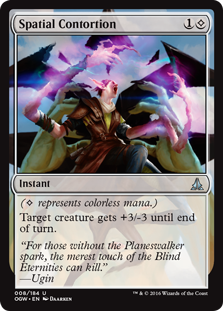 Kill Spells
Kill Spells
Removal-wise, I just have a couple little tips that don't deserve their own sections.
- Spatial Contortion can pump our larger creatures to push through lethal.
- Dismember can kill our blocked creature to fade lifelink from a Wurmcoil Engine.
1017 Brick Squad
I've often heard newcomers express frustration at this deck's "dead draws." But it doesn't really have any. Powder and Guide are often unexciting draws, sure, but they play roles later in the game in addition to as early as its mulligan stage. Regardless, the many micro-synergies explored in this guide tend to vastly overshadow even multiple dead draws—just this week, I beat a guy at the LGS on a mull to 5 after drawing three straight uncastable Powders, all thanks to a couple Scourges. Learn to love the brick!
On that note, this three-part "Mini-Primer" series ended up yielding an utterly comprehensive guide to Colorless Eldrazi Stompy. Hopefully it inspires more Modernites to give the deck a whirl, and who knows... maybe we'll even see some Serum Powders flying around at the Pro Tour this weekend!





Do you believe, sir, that the time has come to cut chalice and replace it with four relics?
No way! In fact, I doubt that time ever comes—Modern will always be wide-open, and always defined by its one-drops. I ran 4 Relic main only when Dredge was at full power. But I can see running Relics instead if you can’t swing the Chalices and want to sling this deck at your LGS anyway. In that case, replace the Guides with a Ghostfire Blade and three other cards.
In game 1 of a match, do you take the play or the draw? I assume you take the play like most aggro decks, but Gemstone Caverns is an unusual consideration.
Always the play, even post-board, and even against 8-Rack! (Want to slam that Chalice or Relic before they strip it). Caverns is here to “give” us the play when we don’t have it.